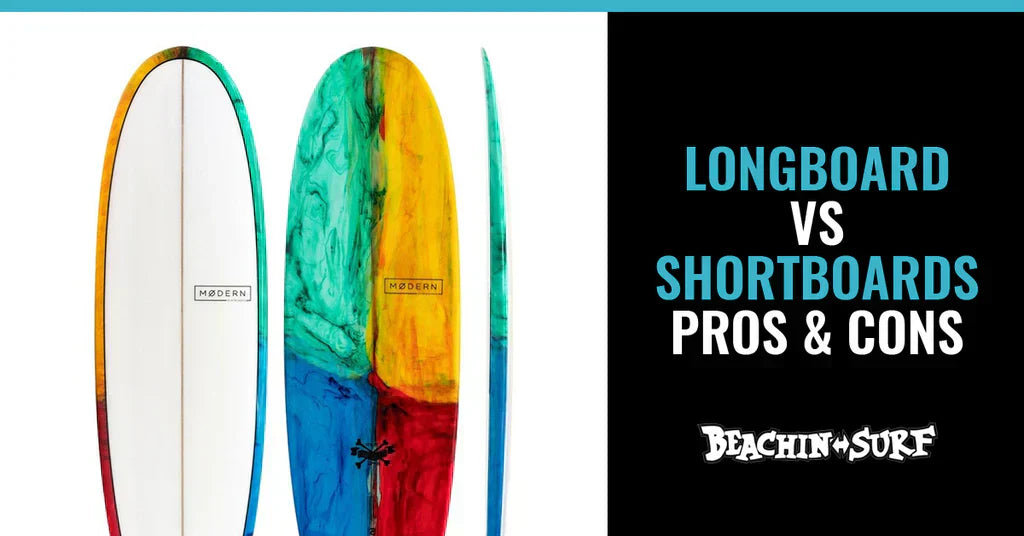
If you are a beginner at surfing, you may have one question in mind: What is the difference between a longboard and shortboard?
Differentiating between the two is important when learning to surf. Longboards and shortboards have their own advantages and disadvantages.
It’s important to remember that surfing is a progression and there are many things to consider when it comes to selecting a surfboard.
Longboards are easier when it comes to paddling, catching waves and standing up. This is the beginner’s main aim.
People with ageing bodies always need a bit of help and very small waves are always much more rewarding on a longer board.
Shortboards are the pinnacle of surfing and there are many varieties but overall they allow for greater maneuverability.
Shortboards can also be used in a much greater range of surfing conditions. The aim is to start on a longboard, and progress to the shortboard.
Kelly Slater was once asked what board a learner should start with. His reply was “start on a longboard and stay on it as long as you can.”
Taking all of the above into account, let’s take a closer look at the differences between longboards and shortboards.
What Is a Longboard?
Any surfing board that is at least 9-feet in length is known as a longboard. If the board length is below 9-feet, it isn’t considered a longboard.
For example, an 8-feet surfing board is known as a mid-length board or a funboard.
The longboard comes with a round nose to ride on mellower waves.
You will also find 1-3 stringers that run through the entire deck of the longboard. This helps control the board and remain as one platform in the water.
Longboards are constructed with different materials including epoxy, foam, fibreglass, and balsa.
These boards vary in terms of thickness, but longboards are usually between 2.5 and 3.25 inches thick in the middle.
You need to take the time to choose the right longboard when planning to surf.
What Is a Shortboard?
A shortboard is a board that is below 7-feet in length. The length and shape of a shortboard are more suited for powerful and fast waves.
Shortboards are much easier to duck dive with – which is a technique of going under the waves in order to reach the lineup.
Some shortboards have stringers while some don’t. Some of these boards come with carbon fibre rails in order to add durability to the board.
A shortboard should be lighter than a longboard which makes it easy to manoeuvre it properly in different surf conditions.
Although some shortboards have fuller and more rounded noses, most of these boards have pointed noses.
That’s because they are meant to be ridden in fast waves.
Shortboards have more variety in their tail shapes. This includes pintails, swallowtails, round tails, bat tails, squash tails, and classic fish tails.
Why Should You Get a Longboard?
Longboards are best for beginner surfers and are the easiest way to learn surfing. These boards are best used in mellow and peeling waves.
The latest high-performance longboard has become popular in Hawaii and Japan. With this board, you can surf with a longboard as if it was a shortboard.
However, you need to train properly as it can take years of practice to develop the skills required to use a longboard as a shortboard.
Why Should You Get a Shortboard?
Intermediate and advanced surfers should go for a shortboard. If you are looking to progress, you should definitely opt for a shortboard.
Performing turns and cutbacks is much easier with a shortboard. It is also easier to carry around a shortboard because it’s much more compact.
If you are looking for speed in your surfing, then you really should invest in a shortboard.
The Pros and Cons of Longboards and Shortboards
Longboard Pros
- Longboards are more stable and ideal for beginner surfers
- They can catch waves much easier than shortboards
- You get more space on a longboard to perform cross-steps and noserides
- A longboard can be ridden in short waves
Longboard Cons
- Longboards are heavy and difficult to transport
- It’s harder to duck dive on a longboard
- They are not good for bigger surf
- They can break easily when not handled properly
Shortboards Pros
- Shortboards are easy to carry because they are compact
- Easy to duck dive on a shortboard
- You can ride fast and hollow waves on a shortboard
- They have a wide variety of fin set-ups
Shortboard Cons
- It’s harder to learn on a shortboard
- They are not good for riding mellow and small waves
- Shortboards are harder to paddle
If you are looking for a trusted surfboard supplier in Australia, then look no further than Beachin Surf. We have a wide range of surfboards and accessories to meet all your surfing needs. Please call us today on (02) 4396 5159 or email us at customerservice@beachinsurf.com.au.
